Mirror: http://tinyurl.com/pgje7lb
Alternative hieroglyphs for karaDa 'hard alloy' are: water-vessel, basket, beehive, duck, antelope, safflower.
Meluhha metalwork competence is exemplified by a gloss: karaḍa'hard metal alloy' (Marathi). This indicates the explorations made by Meluhha artisans to create new metal alloys to make weapons, tools, implements, pots and pans. Alloys are defined by metallic bonding character. This bonding is signified by a gloss: sanghAta 'adamantine glue' (Varahamihira). This gloss is signified by a hieroglyph: sangaDa 'lathe, portable furnace' which is a frequently occurring hieroglyph-multiplex on Indus Script Corpora.
![Image result for sangada lathe]()
Hieroglyphs which signify the Indus Script Corpora, catalogus catalogurm of metalwork with a number of metalwork catalogue items are seen on Ancient Near East artifacts/cylinder seals.
These may be called allographs, that is, hieroglyphs offering the same rebus-metonymy layered reading for a hieroglyph which functions as a homonym, say, for the deciphered semantics: karaḍa 'hard metal alloy' (Marathi)
The hieroglyphs so deployed to encode karaḍa 'hard metal alloy' (Marathi) are sigified in the following examples of artifacts/cylinder seals.
![]() Shu-ilishu cylinder seal. Note the water-vessel held by the woman accompanying the Meluhha merchant. The rollout of Shu-ilishu's Cylinder seal. Courtesy of the Department des Antiquites Orientales, Musee du Louvre, Paris.A Mesopotamian cylinder seal referring to the personal translator of the ancient Indus or Meluhan language, Shu-ilishu, who lived around 2020 BCE during the late Akkadian period. The late Dr. Gregory L. Possehl, a leading Indus scholar, tells the story of getting a fresh rollout of the seal during its visit to the Ancient Cities Exhibition at the Metropolitan Museum of Art in New York in 2004.
Shu-ilishu cylinder seal. Note the water-vessel held by the woman accompanying the Meluhha merchant. The rollout of Shu-ilishu's Cylinder seal. Courtesy of the Department des Antiquites Orientales, Musee du Louvre, Paris.A Mesopotamian cylinder seal referring to the personal translator of the ancient Indus or Meluhan language, Shu-ilishu, who lived around 2020 BCE during the late Akkadian period. The late Dr. Gregory L. Possehl, a leading Indus scholar, tells the story of getting a fresh rollout of the seal during its visit to the Ancient Cities Exhibition at the Metropolitan Museum of Art in New York in 2004.
கரண்டை² karaṇṭai, n. < karaṇḍa. Water- vessel, used by ascetics; கமண்டலம். சிமிலிக் கரண்டையன் (மணி. 3, 86). करोट [p= 255,3] m. a basin , cup L.
![]() British Museum. 22.5 cm h. Wallet shaped chlorite of BMAC. Arye 'lion' Rebus: Ara 'brass' nAga 'serpent' Rebus: nAga 'lead'..
British Museum. 22.5 cm h. Wallet shaped chlorite of BMAC. Arye 'lion' Rebus: Ara 'brass' nAga 'serpent' Rebus: nAga 'lead'..
करण्ड mf(ई L. )n. ( Un2. i , 128) a basket or covered box of bamboo wicker-work BhP. Bhartr2. &c (Samskritam) Karaṇḍaka [fr. last] a box, basket, casket, as dussa˚ Mi. 215=S v. 71=A iv. 230 (in simile); S iii. 131; v. 351 cp. Pug 34; J i 96; iii. 527; v. 473 (here to be changed into koraṇḍaka); DA i. 222 (vilīva˚); SnA 11.Karaṇḍa (m. nt.) [cp. Sk. karaṇḍa, ˚ka, ˚ikā. The Dhātu- mañjūsā expls k. by "bhājanatthe"] 1. a basket or box of wicker -- work Mhvs 31, 98; Dāvs v. 60; DhAiii. 18; -- 2. the cast skin, slough of a serpent D i. 77 (=DA i. 222 ahi -- kañcuka) cp. Dial. i. 88. (Pali) గరిడియ (p. 0358) [ gariḍiya ] gariḍiya. [from Skt. కరండము .] n. A wallet, or basket for food, &c. బుట్ట . M. III. vii. 221. భార. అర . vii. (Telugu)káraṇḍa1 m.n. ʻ basket ʼ BhP., °ḍaka -- m., °ḍī -- f. lex.Pa. karaṇḍa -- m.n., °aka -- m. ʻ wickerwork box ʼ, Pk. karaṁḍa -- , °aya -- m. ʻ basket ʼ, °ḍī -- , °ḍiyā -- f. ʻ small do. ʼ; K. kranḍa m. ʻ large covered trunk ʼ,kronḍu m. ʻ basket of withies for grain ʼ, krünḍü f. ʻ large basket of withies ʼ; Ku. kaṇḍo ʻ basket ʼ; N. kaṇḍi ʻ basket -- like conveyance ʼ; A. karṇi ʻ open clothes basket ʼ; H. kaṇḍī f. ʻ long deep basket ʼ; G. karãḍɔ m. ʻ wicker or metal box ʼ, kãḍiyɔ m. ʻ cane or bamboo box ʼ; M. karãḍ m. ʻ bamboo basket ʼ, °ḍā m. ʻ covered bamboo basket, metal box ʼ, °ḍī f. ʻ small do. ʼ; Si. karan̆ḍuva ʻ small box or casket ʼ. -- Deriv. G. kãḍī m. ʻ snake -- charmer who carries his snakes in a wicker basket ʼ.(CDIAL 2789) kronḍu, Skt. karaṇḍa-, a basket (Kashmiri)
![]() Lothal seal 51 Hieroglyph: pōḷī, ‘dewlap, honeycomb’ pola, 'zebu' Rebus: pola, ‘magnetite’
Lothal seal 51 Hieroglyph: pōḷī, ‘dewlap, honeycomb’ pola, 'zebu' Rebus: pola, ‘magnetite’
करण्ड a [p= 254,2] a bee-hive , honey-comb L.
![]()
Akkadian Cylinder Seal of Adda (c. 2250 B.C.) with, left to right, Ninurta, Ishtar, Shamash, and Ea. From Dury, Art of the Ancient Near and Middle East, Abrams, NY
![Impression of an Indus-style cylinder seal of unknown Near Eastern origin in the Musee du Louvre, Paris. One of the two anthropomorphic figures carved on this seal wears the horns of water buffalo while sitting on a throne with hoofed legs, surrounded by snakes, fishes and water buffaloes. Copyrighted photo by M. Chuzeville for the Departement des antiquites orientales, Musee du Louvre.]()
Impression. Unknown Near Eastern origin. 'One of the two anthropomorphic figures carved on this seal wears the horns of water buffalo while sitting on a throne with hoofed legs, surrounded by snakes, fishes and water buffaloes. Photo by M Chuzeville for Departement des antiquities orientales, Musee du Louvre.' (Parpola, 1998, 2001) http://www.harappa.com/script/parpola0.html (Note 11)
The bird hieroglyph: karaḍa
करण्ड m. a sort of duck L. కారండవము (p. 0274) [ kāraṇḍavamu ] kāraṇḍavamu. [Skt.] n. A sort of duck. (Telugu) karaṭa1 m. ʻ crow ʼ BhP., °aka -- m. lex. [Cf. karaṭu -- , karkaṭu -- m. ʻ Numidian crane ʼ, karēṭu -- , °ēṭavya -- , °ēḍuka -- m. lex., karaṇḍa2 -- m. ʻ duck ʼ lex: see kāraṇḍava -- ]Pk. karaḍa -- m. ʻ crow ʼ, °ḍā -- f. ʻ a partic. kind of bird ʼ; S. karaṛa -- ḍhī˜gu m. ʻ a very large aquatic bird ʼ; L. karṛā m., °ṛī f. ʻ the common teal ʼ.(CDIAL 2787)
![]() Dholavira seal. 117. Antelope kid PUS sun hieroglyph http://bharatkalyan97.blogspot.in/2015/04/two-newly-discovered-seals-from.html
Dholavira seal. 117. Antelope kid PUS sun hieroglyph http://bharatkalyan97.blogspot.in/2015/04/two-newly-discovered-seals-from.html
http://bharatkalyan97.blogspot.in/2015/08/indus-script-hieroglyphs-on-ancient.html . arka 'sun' Rebus: araka, eraka 'copper, moltencast' PLUS करडूं karaḍū 'kid' Rebus: karaḍā 'hard alloy'. Thus, together, the rebus message: hard alloy of copper.
करडूं or करडें [ karaḍū or ṅkaraḍēṃ ] n A kid. (Marathi) కారండవము (p. 0274) [ kāraṇḍavamu ] kāraṇḍavamu. [Skt.] n. A kind of antelopeకన్నెలేడి . (Telugu) కన్నెలేడి [ kannelēḍi ] , or కామిలేడిపిట్ట kanne-lēḍi. [Tel.] n. The bird called the Bastard Florikin: or stone-curlew, &OE;dicnemus scolopax. (F.B.I.) కారండవము .
![]() Safflower bracelet. From the stone reliefs of Ashurnasirpal II. Wrist with a safflower bracelet: safflower karaḍī as fire-god karandi
Safflower bracelet. From the stone reliefs of Ashurnasirpal II. Wrist with a safflower bracelet: safflower karaḍī as fire-god karandi
See: http://bharatkalyan97.blogspot.in/2014/07/tin-road-meluhha-aratta-assur-kanesh.html
करडी [ karaḍī ] f (Seeकरडई ) Safflower: also its seed. (Marathi) karaṭa2 m. ʻ Carthamus tinctorius ʼ lex.Pk. karaḍa -- m. ʻ safflower ʼ, °ḍā -- f. ʻ a tree like the karañja ʼ; M. karḍī, °ḍaī f. ʻ safflower, Carthamus tinctorius and its seed ʼ.M. karḍel n. ʻ oil from the seed of safflower ʼ(CDIAL 2788, 2789)
S. Kalyanaraman
Sarasvati Research Center
August 17, 2015
Alternative hieroglyphs for karaDa 'hard alloy' are: water-vessel, basket, beehive, duck, antelope, safflower.
Meluhha metalwork competence is exemplified by a gloss: karaḍa'hard metal alloy' (Marathi). This indicates the explorations made by Meluhha artisans to create new metal alloys to make weapons, tools, implements, pots and pans. Alloys are defined by metallic bonding character. This bonding is signified by a gloss: sanghAta 'adamantine glue' (Varahamihira). This gloss is signified by a hieroglyph: sangaDa 'lathe, portable furnace' which is a frequently occurring hieroglyph-multiplex on Indus Script Corpora.
Hieroglyphs which signify the Indus Script Corpora, catalogus catalogurm of metalwork with a number of metalwork catalogue items are seen on Ancient Near East artifacts/cylinder seals.
These may be called allographs, that is, hieroglyphs offering the same rebus-metonymy layered reading for a hieroglyph which functions as a homonym, say, for the deciphered semantics: karaḍa 'hard metal alloy' (Marathi)
The hieroglyphs so deployed to encode karaḍa 'hard metal alloy' (Marathi) are sigified in the following examples of artifacts/cylinder seals.
 Shu-ilishu cylinder seal. Note the water-vessel held by the woman accompanying the Meluhha merchant. The rollout of Shu-ilishu's Cylinder seal. Courtesy of the Department des Antiquites Orientales, Musee du Louvre, Paris.A Mesopotamian cylinder seal referring to the personal translator of the ancient Indus or Meluhan language, Shu-ilishu, who lived around 2020 BCE during the late Akkadian period. The late Dr. Gregory L. Possehl, a leading Indus scholar, tells the story of getting a fresh rollout of the seal during its visit to the Ancient Cities Exhibition at the Metropolitan Museum of Art in New York in 2004.
Shu-ilishu cylinder seal. Note the water-vessel held by the woman accompanying the Meluhha merchant. The rollout of Shu-ilishu's Cylinder seal. Courtesy of the Department des Antiquites Orientales, Musee du Louvre, Paris.A Mesopotamian cylinder seal referring to the personal translator of the ancient Indus or Meluhan language, Shu-ilishu, who lived around 2020 BCE during the late Akkadian period. The late Dr. Gregory L. Possehl, a leading Indus scholar, tells the story of getting a fresh rollout of the seal during its visit to the Ancient Cities Exhibition at the Metropolitan Museum of Art in New York in 2004.கரண்டை² karaṇṭai, n. < karaṇḍa. Water- vessel, used by ascetics; கமண்டலம். சிமிலிக் கரண்டையன் (மணி. 3, 86). करोट [p= 255,3] m. a basin , cup L.
 British Museum. 22.5 cm h. Wallet shaped chlorite of BMAC. Arye 'lion' Rebus: Ara 'brass' nAga 'serpent' Rebus: nAga 'lead'..
British Museum. 22.5 cm h. Wallet shaped chlorite of BMAC. Arye 'lion' Rebus: Ara 'brass' nAga 'serpent' Rebus: nAga 'lead'..करण्ड mf(ई L. )n. ( Un2. i , 128) a basket or covered box of bamboo wicker-work BhP. Bhartr2. &c (Samskritam) Karaṇḍaka [fr. last] a box, basket, casket, as dussa˚ M
 Lothal seal 51 Hieroglyph: pōḷī, ‘dewlap, honeycomb’ pola, 'zebu' Rebus: pola, ‘magnetite’
Lothal seal 51 Hieroglyph: pōḷī, ‘dewlap, honeycomb’ pola, 'zebu' Rebus: pola, ‘magnetite’ करण्ड a [p= 254,2] a bee-hive , honey-comb L.

Akkadian Cylinder Seal of Adda (c. 2250 B.C.) with, left to right, Ninurta, Ishtar, Shamash, and Ea. From Dury, Art of the Ancient Near and Middle East, Abrams, NY

Impression. Unknown Near Eastern origin. 'One of the two anthropomorphic figures carved on this seal wears the horns of water buffalo while sitting on a throne with hoofed legs, surrounded by snakes, fishes and water buffaloes. Photo by M Chuzeville for Departement des antiquities orientales, Musee du Louvre.' (Parpola, 1998, 2001) http://www.harappa.com/script/parpola0.html (Note 11)
The bird hieroglyph: karaḍa
करण्ड m. a sort of duck L. కారండవము (p. 0274) [ kāraṇḍavamu ] kāraṇḍavamu. [Skt.] n. A sort of duck. (Telugu) karaṭa
 Dholavira seal. 117. Antelope kid PUS sun hieroglyph http://bharatkalyan97.blogspot.in/2015/04/two-newly-discovered-seals-from.html
Dholavira seal. 117. Antelope kid PUS sun hieroglyph http://bharatkalyan97.blogspot.in/2015/04/two-newly-discovered-seals-from.htmlhttp://bharatkalyan97.blogspot.in/2015/08/indus-script-hieroglyphs-on-ancient.html . arka 'sun' Rebus: araka, eraka 'copper, moltencast' PLUS करडूं karaḍū 'kid' Rebus: karaḍā 'hard alloy'. Thus, together, the rebus message: hard alloy of copper.
करडूं or करडें [ karaḍū or ṅkaraḍēṃ ] n A kid. (Marathi) కారండవము (p. 0274) [ kāraṇḍavamu ] kāraṇḍavamu. [Skt.] n. A kind of antelope
See: http://bharatkalyan97.blogspot.in/2014/07/tin-road-meluhha-aratta-assur-kanesh.html
करडी [ karaḍī ] f (See
S. Kalyanaraman
Sarasvati Research Center
August 17, 2015




















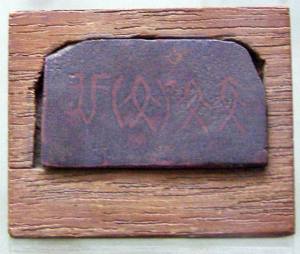 B
B

 Dilmun Seals: Persian Gulf find sites. "
Dilmun Seals: Persian Gulf find sites. "
 Fertile Crescent
Fertile Crescent I suggest that the hierogly-multiplex is rendered in Prakritam speech as:
I suggest that the hierogly-multiplex is rendered in Prakritam speech as:  Sanchi north toraNa with hieroglyph components: mollusc, spathe, safflower, reed
Sanchi north toraNa with hieroglyph components: mollusc, spathe, safflower, reed










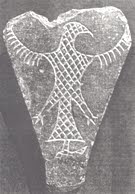
 BACTRIAN BRONZE AXE HEAD
BACTRIAN BRONZE AXE HEAD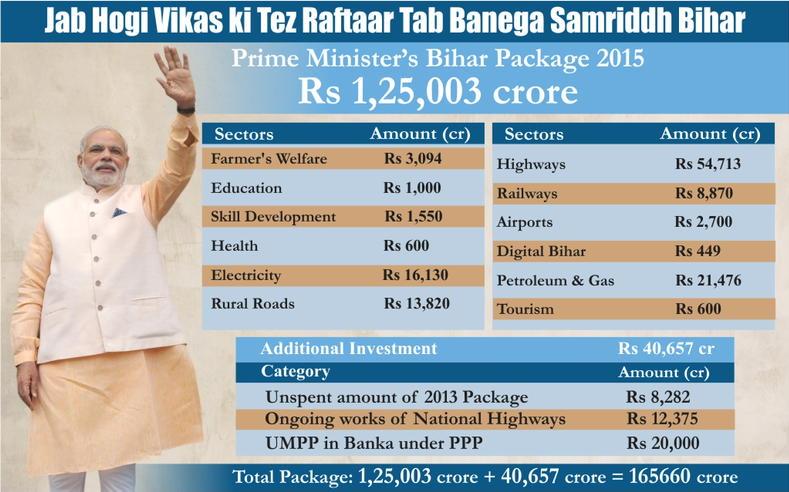







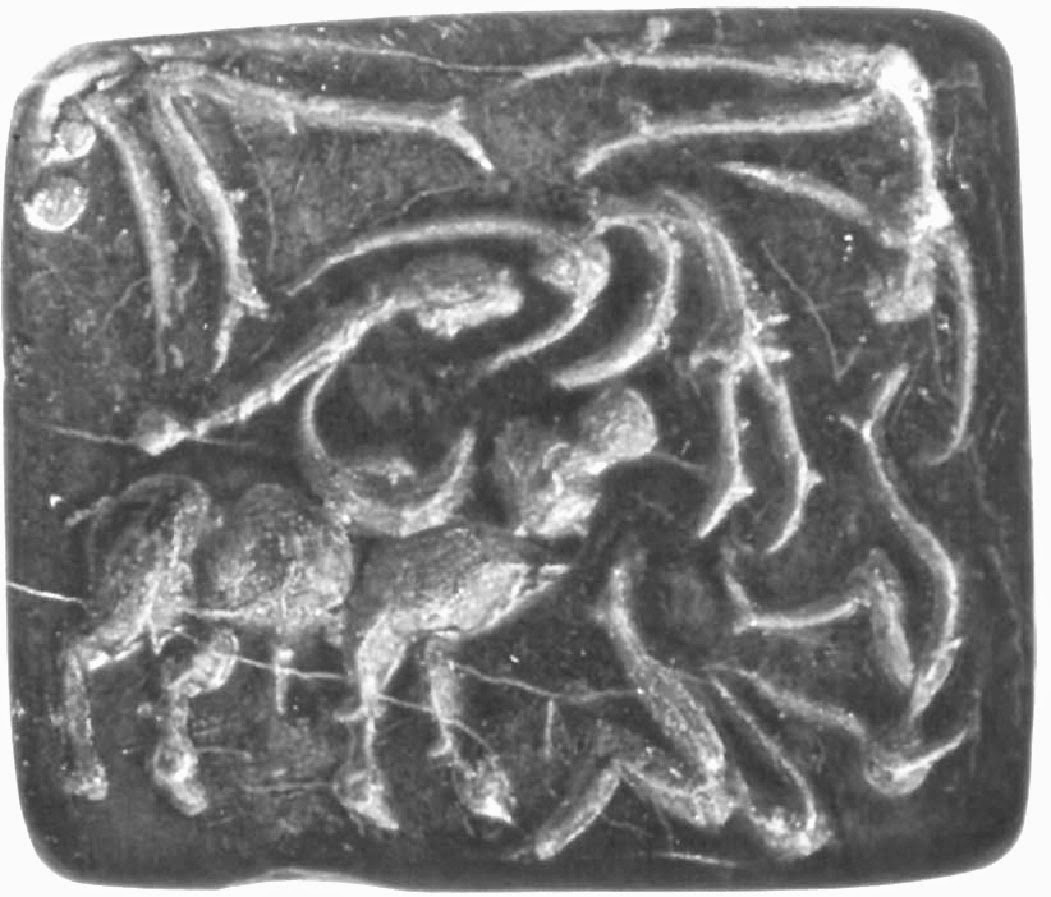










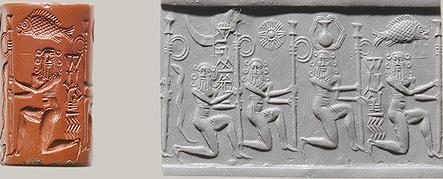


















 Mohenjodaro tablet. m-1475
Mohenjodaro tablet. m-1475 Mohenjodaro seal. m-626
Mohenjodaro seal. m-626 Mohenjodaro seal. m-38
Mohenjodaro seal. m-38 Seal. harappa h-61
Seal. harappa h-61 Seal. Harappa h-12
Seal. Harappa h-12












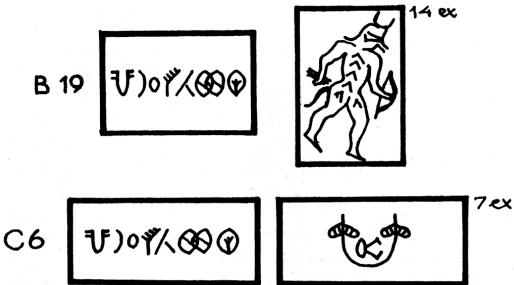



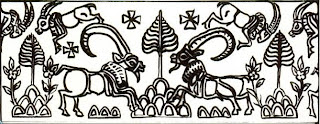

 m0296 See:
m0296 See: 











 On this cylinder seal, the flagposts with rings are shown together with hieroglyphs of: a person carrying an antelope (like the hioeroglyph shown on Shu-ilishu Meluhha translator cylinder seal), overflowing water, fishes, crucible, mountain range, sun (Source:
On this cylinder seal, the flagposts with rings are shown together with hieroglyphs of: a person carrying an antelope (like the hioeroglyph shown on Shu-ilishu Meluhha translator cylinder seal), overflowing water, fishes, crucible, mountain range, sun (Source: 

















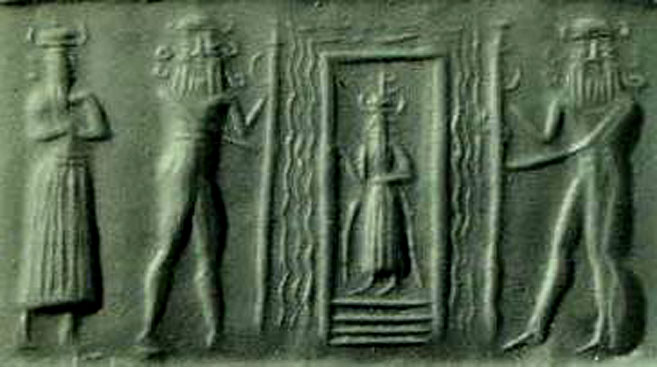





 Water-carrier as a hieroglyph of Indus Script Corpora
Water-carrier as a hieroglyph of Indus Script Corpora


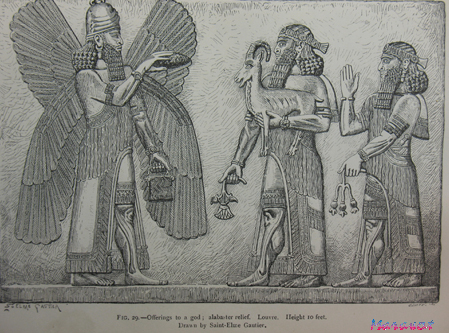



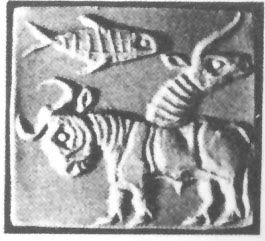









 A fish-apkallu drawn by AH Layard from a stone relief, one of a pair flanking a doorway in the Temple of Ninurta at Kalhu. British Museum. Reproduced in Schlomo Izre'el, Adpa and the South Wind, Language has the power of life and death, Eisenbrauns, 2001.
A fish-apkallu drawn by AH Layard from a stone relief, one of a pair flanking a doorway in the Temple of Ninurta at Kalhu. British Museum. Reproduced in Schlomo Izre'el, Adpa and the South Wind, Language has the power of life and death, Eisenbrauns, 2001.











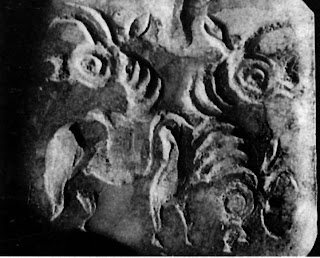 Bet Dwaraka seal.
Bet Dwaraka seal. 



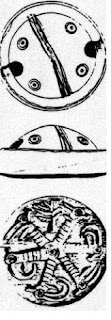
 9351; Nippur; ca. 13th cent. BC; white stone; zebu bull and two pictograms. poLa 'zebu' Rebus: poLa 'magnetite'. goTa 'round object' Rebus: khoTa 'ingot'; bartI 'partridge/quail' (Khotanese); bharati id. (Samskritam) Rebus: bharata 'alloy of copper, pewter, tin'. kuTi 'water-carrier' Rebus: kuThi 'smelter'. Thus, the message is: kuThi poLa khoTa bharata smelter for magnetite, alloy ingot (copper, pewter, tin alloy).
9351; Nippur; ca. 13th cent. BC; white stone; zebu bull and two pictograms. poLa 'zebu' Rebus: poLa 'magnetite'. goTa 'round object' Rebus: khoTa 'ingot'; bartI 'partridge/quail' (Khotanese); bharati id. (Samskritam) Rebus: bharata 'alloy of copper, pewter, tin'. kuTi 'water-carrier' Rebus: kuThi 'smelter'. Thus, the message is: kuThi poLa khoTa bharata smelter for magnetite, alloy ingot (copper, pewter, tin alloy). 9851; Louvre Museum; Luristan; unglazed, gray steatite; short-horned bull and 4 pictograms. barad 'ox' Rebus: bharata 'alloy of copper, pewter, tin'. dula 'pair' Rebus: dul 'cast metal'; PLUS meD 'body' Rebus: meD 'iron' thus, the pair of 'bodies' signify: iron cast metal.
9851; Louvre Museum; Luristan; unglazed, gray steatite; short-horned bull and 4 pictograms. barad 'ox' Rebus: bharata 'alloy of copper, pewter, tin'. dula 'pair' Rebus: dul 'cast metal'; PLUS meD 'body' Rebus: meD 'iron' thus, the pair of 'bodies' signify: iron cast metal. 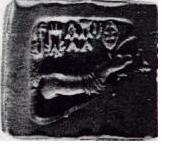
 9908. Iraq museum; glazed steatite; perhaps from an Iraqi site; the one-horned bull, the standard are below a six-sign inscription.
9908. Iraq museum; glazed steatite; perhaps from an Iraqi site; the one-horned bull, the standard are below a six-sign inscription.  Foroughi collection; Luristan; medium gray steatite; bull, crescent, star and net square; of the Dilmun seal type. barad 'ox' Rebus: bharata 'alloy of copper, pewter, tin'; khaNDa 'square divisions' Rebus: khaNDa 'metal implements'; meDha 'polar star' Rebus: meD 'iron'
Foroughi collection; Luristan; medium gray steatite; bull, crescent, star and net square; of the Dilmun seal type. barad 'ox' Rebus: bharata 'alloy of copper, pewter, tin'; khaNDa 'square divisions' Rebus: khaNDa 'metal implements'; meDha 'polar star' Rebus: meD 'iron' 3255; Louvre Museum; Luristan; light yellow stone; seal impression; one side shows four eagles; the eagles hold snakes in their beaks; at the center is a human figure with outstretched limbs; obverse of the seal shows an animal, perhaps a hyena or boar striding across the field, with a smaller animal of the same type depicted above it; comparable to the seal found in Harappa, Vats 1940, II: Pl. XCI.255.
3255; Louvre Museum; Luristan; light yellow stone; seal impression; one side shows four eagles; the eagles hold snakes in their beaks; at the center is a human figure with outstretched limbs; obverse of the seal shows an animal, perhaps a hyena or boar striding across the field, with a smaller animal of the same type depicted above it; comparable to the seal found in Harappa, Vats 1940, II: Pl. XCI.255.
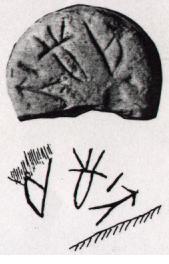 9701; Failaka; unglazed steatite; an arc of four pictograms above the hindquarter of a bull. meD 'body' Rebus: meD 'iron'; sal 'splinter' Rebus: sal 'workshop' goTa 'seed' Rebus: khoT 'ingot' kolmo 'three' Rebus: kolami 'forge, smithy'. kamaDa 'bow' Rebus: kammaTa 'mint, coiner'.
9701; Failaka; unglazed steatite; an arc of four pictograms above the hindquarter of a bull. meD 'body' Rebus: meD 'iron'; sal 'splinter' Rebus: sal 'workshop' goTa 'seed' Rebus: khoT 'ingot' kolmo 'three' Rebus: kolami 'forge, smithy'. kamaDa 'bow' Rebus: kammaTa 'mint, coiner'. 9702; seal, impression, inscription; Failaka; brownish-grey unglazed steatite; Indus pictograms above a short-horned bull. aya 'fish' Rebus: aya 'iron, metal' kanca 'corner' Rebus: kancu 'bronze'
9702; seal, impression, inscription; Failaka; brownish-grey unglazed steatite; Indus pictograms above a short-horned bull. aya 'fish' Rebus: aya 'iron, metal' kanca 'corner' Rebus: kancu 'bronze'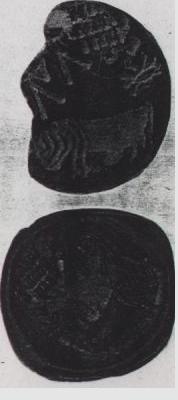 9602; seal, impression; Qala'at al-Bahrain; green steatite; short-horned bull and five pictograms. Found in association with an Isin-Larsa type tablet bearing three Amorite names. barad 'ox' Rebus: bharata 'alloy of copper, pewter, tin'.
9602; seal, impression; Qala'at al-Bahrain; green steatite; short-horned bull and five pictograms. Found in association with an Isin-Larsa type tablet bearing three Amorite names. barad 'ox' Rebus: bharata 'alloy of copper, pewter, tin'. Qala'at al-Bahrain; ca. 2050-1900 BC; tablet, found in the same level where 8 Dilmun seals and six Harappan type weights were found. Three Amorite names are: Janbi-naim; Ila-milkum; Jis.i-tambu (son of Janbi-naim)
Qala'at al-Bahrain; ca. 2050-1900 BC; tablet, found in the same level where 8 Dilmun seals and six Harappan type weights were found. Three Amorite names are: Janbi-naim; Ila-milkum; Jis.i-tambu (son of Janbi-naim) Two seals from Gonur 1 in the Murghab delta; dark brown stone (Sarianidi 1981 b: 232-233, Fig. 7, 8); eagle engraced on one face. garuDa 'eagle' Rebus: karaDa 'hard alloy' nAga 'serpent' Rebus: nAga 'lead'
Two seals from Gonur 1 in the Murghab delta; dark brown stone (Sarianidi 1981 b: 232-233, Fig. 7, 8); eagle engraced on one face. garuDa 'eagle' Rebus: karaDa 'hard alloy' nAga 'serpent' Rebus: nAga 'lead' 9601; Qala'at al-Bahrain; light-grey steatite; hindquarters of a bull and two pictograms. barad 'ox' Rebus: bharata 'alloy of copper, pewter, tin'
9601; Qala'at al-Bahrain; light-grey steatite; hindquarters of a bull and two pictograms. barad 'ox' Rebus: bharata 'alloy of copper, pewter, tin'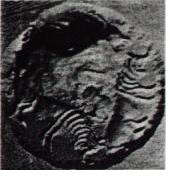 Seal impression; Dept. of Antiquities, Bahrain; three Harapan-style bulls. barad 'ox' Rebus: bharata 'alloy of copper, pewter, tin' kolmo 'three' Rebus: kolami 'smithy, forge'.
Seal impression; Dept. of Antiquities, Bahrain; three Harapan-style bulls. barad 'ox' Rebus: bharata 'alloy of copper, pewter, tin' kolmo 'three' Rebus: kolami 'smithy, forge'.
Reply
Reply
Reply
Reply
Reply
Reply
Reply
Reply